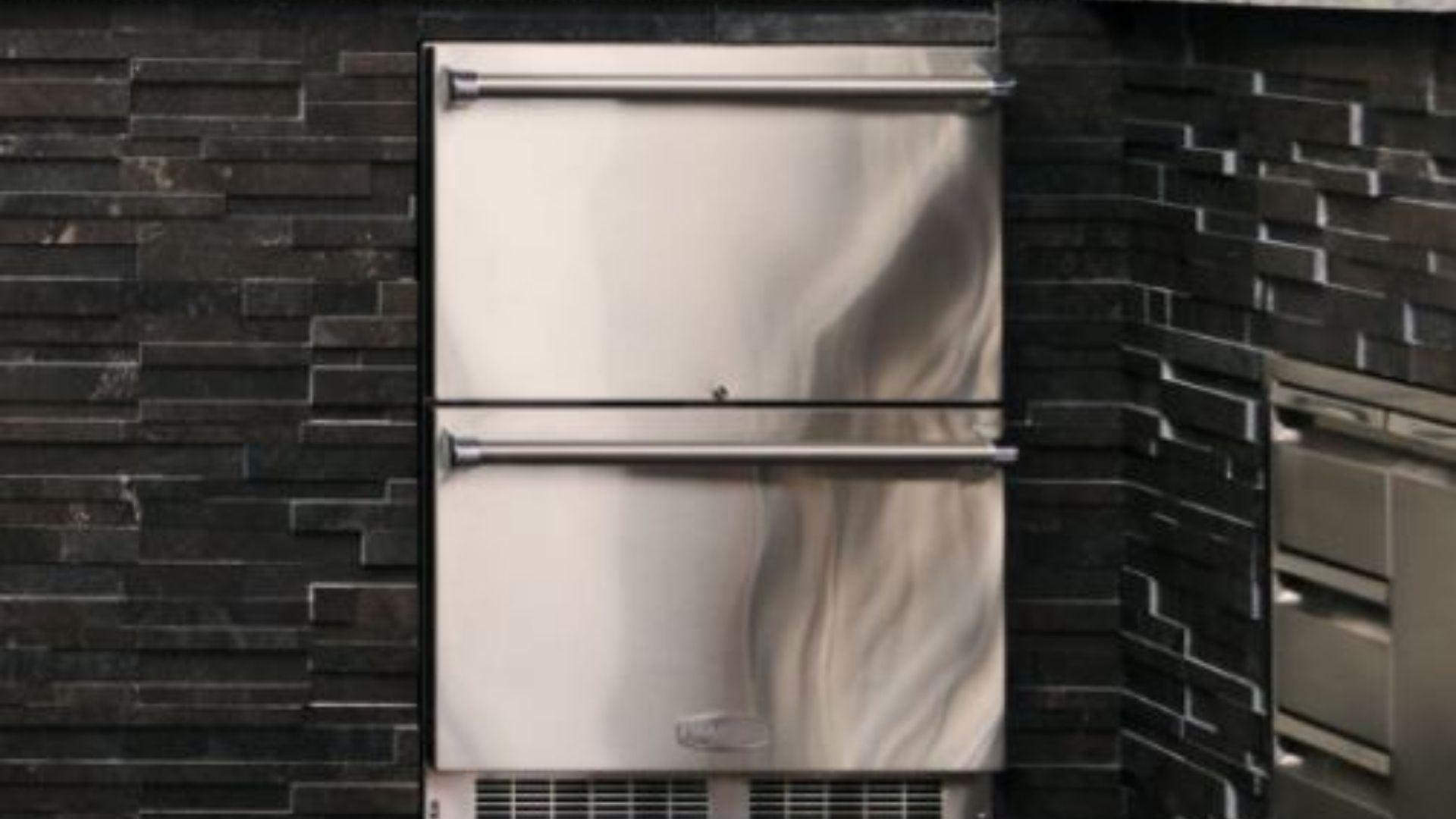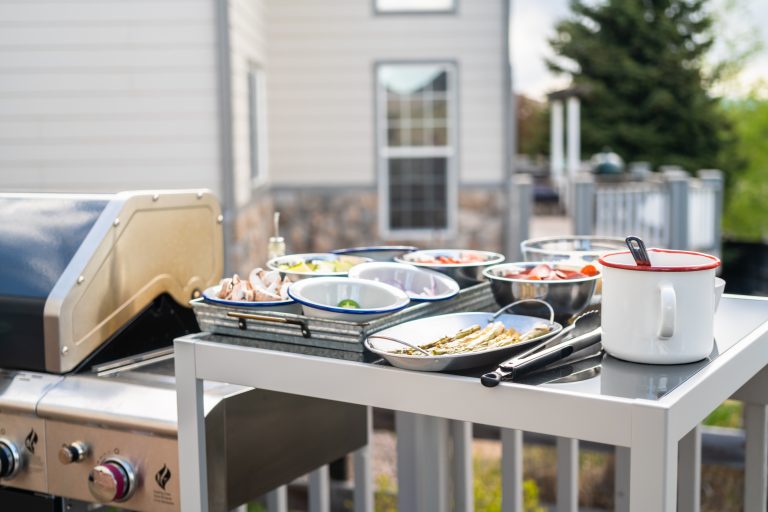What You Should Know About How to Protect an Outdoor Refrigerator
Selecting and Protecting Your Outdoor Refrigerator
All refrigerators are not created equal and this is especially true when it comes to getting an outdoor refrigerator for your outdoor kitchen or backyard bar.
Designed for quick cooling, refrigerator-freezers are able to keep food cold enough to prevent spoiling. A refrigerator will keep foods cold enough to prevent bacteria growth. This is not true of beverage coolers which are another option to keep drinks cold outdoors. Beverage coolers will chill beverages, but not cold enough to discourage bacterial growth.
Freezers can be used year round and should offer a range of features from an adjustable thermostat to a door alarm, which alerts users when the door has been left open too long. This is a great feature especially if you don’t use the fridge outside regularly.
What outdoor refrigerator-freezer will work best for you?
Before making an outdoor refrigerator-freezer purchase, there are several things to keep in mind.
First, the refrigerator or refrigerator-freezer that works well inside the home might not be ideal outside because of its inability to handle heat and humidity, which can cause internal components to rust and corrode. As such, it’s important to make sure your refrigerator is an outdoor rated fridge with a durable stainless steel body and sealable doors and drawers that can withstand moisture build up.
In terms of appearance, refrigerator-freezers come in every imaginable finish and color making it easy to find one that will blend with your outdoor kitchen or bar’s design style. But the tried and true finish is stainless steel for its ability to resist rust and coordinate with grills, ice makers and sinks which are the most popular finishes for these outdoor rated kitchen appliances.
Finally refrigerator-freezer doors should open smoothly without the need for excessive force leaving both hands free to place items inside. The refrigerator door should also contain an adjustable thermostat.
How Large Should an Outdoor Refrigerator Be?
The size of your refrigerator is typically determined by how far your outdoor kitchen or bar is from your main indoor kitchen. The larger the outdoor fridge, the fewer trips indoors to gather needed foodstuffs.
No matter what you have in mind for your outdoor kitchen or bar, consider investing in refrigerator-freezer with at least 4 cubic feet of interior capacity. Outdoor refrigerators typically fall in the 2.7 to 5.6 cubic foot range. This will give you as the host plenty of space to store all your guests’ favorite drinks and food items without taking up too much space on your bar or outdoor kitchen countertop.
Outdoor Fridge Construction
When choosing refrigerator-freezer doors, look for models that open smoothly without using too much force, as this will leave both hands free to fill up their contents when placing items in the refrigerator. Always make sure there is a drain hose connection near the back of the refrigerator to protect against water damage caused by condensation that may drip off the refrigerator-freezers’ exterior surface. If the refrigerator door has additional insulation, you’ll benefit by using less energy to keep your food and beverages at the optimal temperature.
In addition, a refrigerator designed for outdoor use will be made of stainless steel and should feature removable shelves so they can be easily cleaned. Finally refrigerator-freezer doors should ideally have an interior light to help illuminate food items in dark areas making it easier to find what you are looking for as well as alerting you to any difference in temperature within the refrigerator.
Indoor Refrigerator vs. Outdoor Refrigerators: Things that are different
It is important to protect your outdoor fridge from the elements. Weather resistant does not mean weatherproof. Condensation will form on the refrigerator’s surface and run down to its base. You may want to place a small tray under your refrigerator for easy drainage of water. However, this does not replace the need for properly sealing your refrigerator-freezer doors.
To protect against rain damage, always close refrigerator doors when it is raining or snowing; you can also use weatherproof curtains to cover refrigerator door opening if the area under your refrigerator gets exposed to extreme weather conditions.
There are other differences between indoor and outdoor refrigerators. The first is the range of ambient temperatures. Refrigerators must work hard to keep everything inside cold, regardless of the outside temperature. We maintain a consistent temperature in our residences, ranging between 60 and 80 degrees Fahrenheit.
Temperatures outside can shift considerably from dawn to night, ranging from bitterly cold to scorching hot. In that highly unstable environment, outdoor refrigerators must maintain consistent cold temperatures.
To keep everything cool in the summer heat, a fridge would need greater insulation and more powerful compressors and components.
The electrical components must also be weatherproofed. Outside refrigerators, even when constructed within a cabinet or other outdoor appliance, might be exposed to water from rain, splashing in a pool area, or other sources. Because water and electricity are such a deadly combination, specific safeguards are made in the design to prevent the risk of electrocution. Make sure your refrigerator is approved by Underwriters’ Laboratories for outdoor use to be safe.
Outdoor rated refrigerators are more expensive. The materials are heavy-duty, there is more insulation, and the mechanics are more powerful to accommodate wider temperature ranges.
Aesthetically, if you are spending thousands of dollars on a grill, consider how a cheap “dorm fridge” will affect the appearance of your outdoor kitchen. Continuity counts.
Outdoor Does Not imply All-Weather
The purpose of this weatherproofing is to protect the electrical components from water. It doesn’t imply you can leave it entirely exposed to the elements in the worst of storms or use it in the coldest of winters.
Stainless steel is used in almost all outdoor refrigerators due to its ability to resist rust in moist situations. Stainless steel, on the other hand, can rust even in the harshest of environments. Furthermore, not every stainless steel has the same amount of corrosion resistance.
You’ll want to get a fridge made of a higher grade of stainless steel to minimize rust, which is a little more expensive. Models made of a lower quality of stainless steel (which is more prone to rust) or plastic-wrapped steel will be less expensive.
Protect Your Refrigerator with a Cover
In exceptionally wet weather, you may also wish to cover your refrigerator.
Outdoor refrigerators, like their indoor counterparts, are not designed to operate when temperatures drop under 40 F. degrees. That is the temperature of the fridge, everything is kept on the inside. There’s no need to turn on the refrigerator if it’s already cold outside.
This can result in issues such as the freezer portion failing to turn on, causing everything within to defrost and perish. If you keep your refrigerator outside during the winter, it’s best to empty it, unplug it, and cover it for the season. (You might want to also leave the door slightly ajar to allow air to circulate and prevent mold.)
Protect Your Outdoor Refrigerator from Rodents
Rodents are attracted to spilled food and food debris that may accumulate under your outdoor kitchen cabinets. Keeping your work area and cabinet area clean and free of food will go a long way towards deterring mice from your outdoor kitchen.
However, mice will eat anything and are attracted to the warm spaces under your kitchen appliances especially in cooler weather. They also will gnaw on electrical wires which will cause electrical problems and potential fire hazards.
To protect your outdoor refrigerator from mice you can encase the wires in a cord management system, use conduit pipe to protect the cords or use a natural mice repellent.
Natural repellents include oils such as peppermint, balsam, citrus or menthol to keep mice from taking up residence under your outdoor appliances. Some people claim that mothballs and fabric softener sheets do the same thing.
Use preventative measures such as keeping the area clean first to dissuade rodents from taking up residence under your refrigerator. For an extra measure of prevention, use one of the recommended oils to make the environment inhospitable to them.
Where to Install: Freestanding or Undercabinet
If you’re intending to install your refrigerator into an outdoor kitchen island or some other type of cabinetry, make sure it’s built to do so.
Refrigerators require adequate ventilation to keep its components operating correctly and to transport heat away from the unit. Refrigerators that are designated as “built-in” have vents in the front (typically on the bottom) so that they can be flush mounted in a cabinet or island.
Refrigerators that stand alone require ventilation at the back, top, and sides. You’ll limit its capacity to function correctly and keep things cool if you build it flush into a cabinet or kitchen island.
You can still put a freestanding model under a counter, but you’ll need to provide enough space on all sides for ventilation.
The Right Outdoor Refrigerator
No matter where you want to put your fridge outside, you have the same considerations that you would have with all outdoor appliances. It should be outdoor rated and UL approved. It needs adequate ventilation – even a garage refrigerator. An outdoor fridge should be able to withstand the elements and be somewhat protected inside cabinetry or under a roof or awning to ensure maximum longevity.
Your safety and that of your family and guests is of paramount importance when dealing with electricity outdoors. You’ll be happier with the fridge you buy if you know how to protect it.







